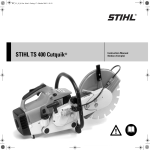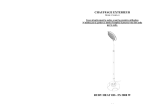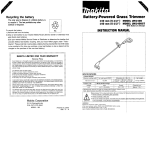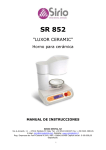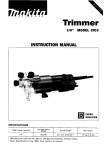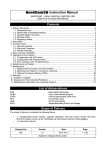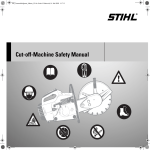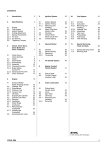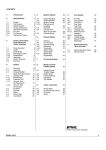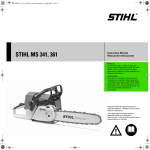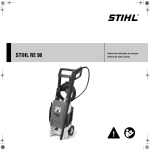Download TS 360 TS 350 AVE
Transcript
STIHL TS 360,350 AVE 1 Service Manual Cutquik TS 360, 350 AVE Only the assemblies and components typically featured in the TS 360, 350 AVE are described in this Service Manual. All other repair work is described in Manual 08 S. You should make use of the illustrated parts list while carrying out repair work. They show the installed positions of the individual components and assemblies. Microfilmed parts list are always more up to date than printed lists! Refer to the "Technical Information Bulletins" for engineering changes which have been introduced since publication of this service manual. Service manuals and technical information bulletins describing engineering changes are intended exclusively for the use of STIHL servicing dealers and staff and must not be passed on to third parties. The STIHL Special Tools manual lists all special servicing tools currently available from STIHL. Always use original STIHL replacement parts. Original STIHL parts can be identified by the STIHL part number, the STIHl logo and the STIHL parts symbol ( . The symbol may appear alone on small parts. A fault on the machine may have several causes. Consult the "troubleshooting charts" when tracing faults. STIHl STIHL TS 360,350 AVE 2 CONTENTS 1. Tightening torques 2 4.1.3 4.1.4 4.1.5 4.1.6 4.1.7 Ignition lead plug Ignition lead Stop switch lead Stop switch Flywheel 16 17 18 18 19 2. Drive for abrasive body 3 2.1 2.2 Bearing with guard Check the axial and radial truth of running V-belt V-belt pulley (clutch drum) 3 7 9 5. AV handle system/frame 20 9 5.1 5.2 Buffer ring Handle frame 20 21 3. Air filter 11 6. Special servicing tools and aids 23 3.1 3.2 Air filter Filter housing 11 12 Special servicing tools Servicing aids 23 23 4. Ignition system 13 4.1 4.1.1 4.1.2 4.1.2.1 4.1.2.2 Repairing the components Spark plug Module plate Ignition timing Removal Installation 13 13 15 15 15 1. Tightening torques 2.3 2.4 Fastener Self-tapping cheese-head screw Flat head screw Cheese-head screw Cheese-head screw Cheese-head screw Countersunk screw Cheese-head screw Cheese-head screw Cheese-head screw Cheese-head screw Locking screw Nut Nut Nut Hexagon bolt Cheese-head screw Nut 1) Only for USA Thread size IS-B4,2x9,5 M4x12 IS-M4x16 IS-M5x33 IS-M5x30x22 M6x12 IS-M6x18 IS-M6x18 IS-M6x24 IS-M6x40 M8 M10X1 M10x1 L M10x1 L M10x35 IS-M6x20 M12x0,75 M14x1,25 6.1 6.2 For component Rubber vibration buffer/ handle frame Guard for cutting wheel Module plate Fan housing Fan housing Limit stop/bearing Filter housing Buffer ring Buffer ring/handle frame Support/handle frame Filter cover Flywheel V-belt pulley V-belt pulley, front Connecting piece Connecting piece Stop switch Spark plug Torque Nm Remarks (kpm) 3.0 3.3 4.0 5.0 5.0 7.0 6.5 7.0 7.5 7.5 12.0 27.5 32.5 37.5 47.5 8.5 2.7 27.5 (0.3) (0.33) (0.4) (0.5) (0.5) (0.7) (0.65) (0.7) (0.75) (0.75) (1.2) (2.75) (3.25) (3.75) (4.75) (0.85) (0.27) (2.75) 1) STIHL TS 360,350 AVE 2. DRIVE FOR ABRASIVE BODY 2.1 Bearing with guard 3 Top: 1 = Guard (new version) 2 = Size 19 fastening bolts for bearing Bottom: 1 = Guard (former version) 2 = Size 13 fastening bolts for bearing Top: Removing the bearing Top: Removing the axial clamp ring 1 =Thrust washer Bottom: Pliers 0811 611 8200 Bottom: Unscrewing the nut - Check axial and radial truth of running; see 2.2. - Lift the bearing with guard out of the V-belt. - Unscrew the fastening bolts on the bearing and remove the guard. - Draw the axial clamp ring off the shaft. Note: The former machine versions feature a steel guard and size 13 hexagon bolts. - Remove the thrust washer. - Lock the V-belt pulley. Unscrew the nut and draw the V-belt pulley off the shaft Important! The nut has a left-hand thread. STIHL TS 360,350 AVE 4 Top: 1 = Woodruff key 2 = Washer Top: Flat head screws Top: 1 = Rubber washer 2 = Disk Bottom: Removing the shaft Bottom: Removing the flange Bottom: Removing the bearing - Remove the Woodruff key from the groove in the shaft. - Remove the washer from the shaft. - Draw the shaft out of the deep-groove ball bearings. - Unscrew both flat head screws and remove them together with the spring washers. - Remove the disk and rubber washer from the flange and guard. Note: Note the number of spring washers. - Remove the bearing from the guard. - Remove the flange from the guard. STIHL TS 360,350 AVE Top: Removing the rubber ring Bottom: 1 = Rubber washer 2 = Disk 5 Top: 1 = Countersunk screw 2 = Limit stop 3 = Cheese-head screw 4 = Rubber vibration buffer Bottom: Pliers 0811 641 8380 - Remove the rubber ring from the bearing. - Unscrew the countersunk screw and remove the limit stop. - Remove the rubber washer and disk from the bearing. - Unscrew the cheese-head screw in order to replace the rubber vibration buffer. Note: The limit stop and rubber vibration buffer only feature in machines for the USA. Top: Removing a circlip Bottom: Pressing out the deep-groove ball bearings with drift pin 4119 893 7200 - Remove the circlips from the grooves before removing the deep-groove ball bearings. - Force both deep-groove ball bearings and the ring out of the bearing with the drift pin. STIHL TS 360,350 AVE Top: Fastening bolts for the flange Bottom: Fitting the circlip with pliers 0811 641 8380 - Unscrew the fastening screws on the flange and remove the flange from the guard. The parts are assembled in reverse order. Note: Particular care must be taken when carrying out the following work. - Place the circlip in one of the bearing grooves. 6 Top: 1 = Deep-groove ball bearing 2 = Ring Bottom: Pressing in the deep-groove ball bearings - Slide the first deep-groove ball bearing onto the shaft, then the ring and the second deep-groove ball bearing. - Position the deep-groove ball bearings and press them in with the shaft until they contact the circlip. - Draw the shaft out of the deepgroove ball bearings. - Place the second circlip in the bearing groove. Top: Correctly positioned spring washers Bottom: Longer collar on the V-belt pulley - Slide the same number of spring washers onto the flat head screws as were removed during disassembly, as shown in the drawing. - Slip the V-belt pulley onto the shaft with the longer chamfered edge first and tighten the nut with a torque of 37.5 Nm (3.75 kpm). STIHL TS 360,350 AVE 7 2.2 Tightening the segment 1 = Fastening bolts 2 = Segment - Place the segment under the rear bolt on the bearing and lightly tighten the bolt. - Using a size 13 open-jaw wrench, turn the segment clockwise until the V-belt is correctly tensioned. - Then securely tighten all three fastening bolts, starting with the bolt at the rear (with segment). Note: The V-belt is correctly tensioned when it can be slightly depressed (5 - 10 mm) by moderately pressing with the fingers in the middle between the two V-belt pulleys. Important! Excessive tension in the V-belt increases the wear. Check the axial and radial truth of running Top: Fitting the test wheel 1 = Arresting grooves 2 = Arresting lugs 1 = Test wheel 5910 851 6100 2 = Gauge holder 5910 850 6000 3 = Dial gauge 0000 890 9100 Bottom: Test equipment in position Since changes in the shaft diameter (due to scoring etc.) can affect the radial truth of running of the cutting wheel, it is normally sufficient carefully to inspect the shaft around the cutting wheel mount. The axial truth of running, on the other hand, depends on the state of various components and must therefore be determined by measurement. - Fit the test wheel and then position the thrust washer so that the arresting lugs engage in the arresting grooves in the shaft. - Tighten the screw. - Secure the gauge holder with dial gauge to the guard cover so that the axial truth of running can be determined for a diameter of approx. 130 mm over one full revolution of the wheel. Refer to the table "Test procedure". - Remove the test equipment after completing the measurement. STIHL TS 360,350 AVE Test procedure Radial truth of running: Visual inspection of the spindle (shaft) Axial truth of running: Check the axial truth of running with the STIHL test wheel or diamond cutting wheel (over a diameter of 130 mm) 8 Actual condition Possible causes Remedy Wear marks or scoring around the cutting wheel mount Fastening screw loose, use of wrong cutting wheels (diameter of mount > 20 mm or > 22 mm) Replace the spindle (shaft) Axial eccentricity ≤ 0.15 mm > 0.15 mm Damaged or uneven contact surfaces of the thrust washers (especially the inner thrust washer); contact surfaces not plane; genuine STIHL parts have not been used None Dirt; thrust washers or Replace the cutting wheel fitted incorrectly; thrust washers application of force when cutting or during transport Spindle (shaft) damaged Incorrect handling, use of force Replace the spindle (shaft) Distinct radial play in the bearing seat spindle bearing defective Deep-groove ball bearings damaged by exposure to dirt and/or bearing seat worn down at the spindle Replace the spindle and deep-groove ball bearings STIHL TS 360,350 AVE 2.3 9 V-belt 2.4 Top: Fastening screws for the connecting piece and fastening screw on the front handle Bottom: Removing the connecting piece V-belt pulley (clutch drum) Top: Stop screw 1107 191 1200 Connecting piece with V-belt in position Bottom: Stop screw in cylinder - Remove the V-belt. - Place a new V-belt in the connecting piece. - Position the connecting piece and retighten the fastening screws. Note: Check the position of the V-belt and that it moves easily before tightening the fastening screws. - Remove the bearing with guard; see 2.1. - Unscrew the fastening screws on the connecting piece and on the front handle. - Push the power unit aside slightly and remove the connecting piece. Tighten the two cheese-head screws with a torque of 8.5 Nm (0.85 kpm) and the hexagon screw with a torque of 47.5 Nm (4.75 kpm). - Replace the bearing with guard; see 2.1. - Remove the V-belt; see 2.3. - Unplug the ignition lead. - Unscrew the spark plug and screw in the stop screw instead, turning it into the cylinder as far as possible, so that the crank shaft is arrested. STIHL TS 360,350 AVE 10 Top: Unscrewing the fastening nut Top: Forcing out the needle sleeve Top: 1 = Disk 2 = Bushing Bottom: Assembly pin 1119 893 7200 Bottom: Friction surface of the clutch drum Bottom: Correctly positioned needle sleeve - Unscrew the fastening nut from the V-belt pulley Important! The nut has a left-hand thread. - Draw the V-belt pulley off the crank shaft journal. - Check the needle sleeve and force it off the V-belt pulley from the clutch side using an assembly pin if necessary. - Check the clutch drum; it must not show any major signs of wear or scoring. Replace the V-belt pulley if necessary. - Draw the bushing and disk off the crank shaft journal. The parts are assembled in reverse order. Note: The assembly pin must be positioned on the thicker, beaded side of the needle sleeve and forced in from the clutch drum side until it is flush with the inner edge of the V-belt pulley. Tighten the fastening nut with a torque of 32.5 Nm (3.25 kpm). STIHL TS 360,350 AVE 3. AIR FILTER 3.1 Air filter Top: Screw plug on top of the filter Bottom: Removing the prefilter 11 Top: Unscrewing the wing nut Bottom: Removing the main filter 1 = Cover lid Removing the auxiliary filter - Rinse the prefilter in clean naphtha if it is extremely dirty. Note: The prefilter must be completely dry before it is replaced. - Unscrew the wing nut on the screw plug - Remove the main filter and press the cover lid out of the main filter. The purpose of the air filter is to collect the dirt entrained with the combustion air and thus minimize the amount of wear in the power unit. - Before removing the filter, close the choke shutter so that dirt cannot enter the carburetor. This is done by drawing out the choke. Clogged filters reduce the engine efficiency, increase the fuel consumption and make it more difficult to start the equipment. - Unscrew the screw plug on the filter cover and remove the filter cover. For this reason, the air filter must always be cleaned as soon as the engine power deteriorates. - Remove the prefilter from the main filter and knock it clean. Note: The main filter must be replaced if it is soiled. - Draw the auxiliary filter off the flange bolt, gently tap it clean and rinse in a clean, nonflammable solution (such as hot soapy water). Note: The auxiliary filter must be replaced immediately if the flock coating is defective. STIHL TS 360,350 AVE 3.2 12 Filter housing Top: Plug on ignition lead Bottom: Grommet - Remove the air filter; see 3.1. - Remove the fan housing; see 4.1.7. - Disconnect the ignition lead from the spark plug. - Draw the grommet for the ignition lead out of the filter housing. Top: Locking screw Bottom: Fastening screws for the filter housing Top: Removing the filter housing Bottom: Positioning the filter housing - Unscrew the locking screw from the filter housing. The parts are assembled in reverse order. - Unscrew the fastening screws from the filter housing. Note: Draw the manifold through the opening before positioning the filter housing and tighten the fastening screws with a torque of 6.5 Nm (0.65 kpm). Coat the thread of the locking screw with Loctite (see 6.2) and tighten with a torque of 12.0 Nm (1.2 kpm). Note: The screws at the rear are located below the manifold. - Draw the filter housing upwards, pressing the manifold out through the opening at the same time. STIHL TS 360,350 AVE 4. IGNITION SYSTEM Important! Utmost care must be taken both during troubleshooting and when carrying out maintenance and repair work on the ignition system. The high voltages may cause fatal accidents! 13 4.1 Repairing the components 4.1.1 Spark plug Top: Checking the electrode gap with a caliper gauge Bottom: Adjusting the ground electrode with a Bosch setting gauge Module plate Troubleshooting in the ignition system should always start with the spark plug. First check the spark plug designation if the machine refuses to start, if the engine power is unsatisfactory or if the ignition cuts out, etc. Only Bosch spark plugs of type WSR 6 F or NGK BPMR 7 A may be used. Other types of spark plug and plugs made by other manufacturers cannot be used on account of the large electrode size. The STIHL Cutquiks TS 360, 350 AVE are fitted with a transistorized (breakerless) magneto-ignition system that is not dependent on external power supplies (battery, dynamo, etc.). The ignition system basically comprises the module plate and flywheel and is easily accessible. Spark plug blackened or charred: - Clean with brass wire brush and then blow through with compressed air. Note: Do not use a steel wire brush. Spark plug covered with oil: - Wash the insulator nose with a grease solvent and then blow through with compressed air. Electrode gap: The gap between electrodes increases as a result of the natural burn-off. - The electrode gap must be checked regularly with a caliper gauge. The gap must be equal to 0.5 mm. - The ground electrode must be adjusted accordingly if necessary. Important! A new spark plug must be fitted without fail if the electrodes have burned down severely. STIHL TS 360,350 AVE Checking the spark plug: The spark plug can only be checked correctly with the aid of a spark plug tester. As a provisional measure, the spark plug can also be inserted in the ignition lead plug and connected to ground after being dismantled and cleaned. Considerable sparking must be evident at the electrodes when the starter is pulled. 14 Important! Never touch live parts: the high voltages can cause fatal accidents. Note: If in doubt, install a new spark plug in place of the old one. The cable connections must then be checked if sparking is not observed although the spark plug is in perfect condition. Note: Frayed insulation on the ignition and stop switch leads can cause short-circuits to ground preventing the engine from starting or causing it to malfunction. Installation of the spark plug: - Clean the spark plug and check that the gasket is undamaged. - Screw in the spark plug and tighten with a torque of 27.5 Nm (2.75 kpm). The appearance of the insulator nose, the "face of the spark plug", is a major source of information on the effects of different operating conditions: Condition of the insulator nose Examples of corresponding operating conditions Normal: Greyish-yellow to brown, dry Engine OK, correct spark plug (heat range as specified) Charred: Velvety, dull black layer of soot Mixture too rich, lack of air (air filter clogged, choke partly closed), electrode gap too large, wrong spark plug (heat range too high) Covered with oil: Layer of damp carbon oil and soot Fuel mixture contains too much oil Overheated: Beading on the insulator nose, corroded electrodes Mixture too lean, spark plug loose, wrong spark plug (heat range too low) STIHL TS 360,350 AVE 4.1.2 Module plate 15 4.1.2.1 Ignition timing 4.1.2.2 Removal and installation Top: Grommet Bottom: Fastening bolts for the module plate 1 = High-voltage output 2 = Tab In electronically controlled (breakerless) magneto-ignition systems, the ignition timing has been set at 2.1 mm before the UDC at n = 8000 rpm and cannot be adjusted. Taking into account the permissible variation in the elelctronic circuit, this value may range from 1.9 to 2.5 mm before the UDC at n = 8000 rpm. Since these systems are not subject to mechanical wear, the ignition timing does not change during operation. The module plate contains all the functional parts required for ignition timing control. Only two electrical connections emerge from the coil assembly: 1. The high-voltage output 2. The tab for connecting the stop switch lead Correct functioning of the module plate can only be checked with the aid of a complex test unit. For this reason, the workshop tests should be limited exclusively to checking the sparking. The complete module plate must be replaced if there is no spark (although the leads and stop switch are intact). However, defects inside the circuitry may cause the timing to change in such a way as to produce positive spark control although the timing itself is outside the permissible range so that the starting and operating characteristics deteriorate. - Remove the flywheel; see 4.1.7. - Remove the filter housing; see 3.2. - Remove the grommet for the ignition lead from the mount of the crank case. - Unscrew the fastening bolts from the module plate. STIHL TS 360,350 AVE 16 4.1.3 Top: Stop switch lead Bottom: Drawing the unscrewed ignition lead out of the high-voltage dome Ignition lead plug Top: 1 = Ignition lead plug 2 = Grommet Markings on the module plate and crank case Bottom: Removing the spiral spring from the ignition lead plug - Unscrew the ignition lead from the contact pin and draw it out of the high-voltage dome. Note: The high-voltage dome must be filled with STIHL multipurpose grease (0781 120 1109) before screwing in the ignition lead. Important! Graphite (Molykote) grease and silicone insulating paste must not be used. - Slide the protective sleeve over the high-voltage dome. - Remove the module plate from the crank shaft journal and disconnect the stop switch lead from the module plate. - Draw the module plate slightly forwards, pulling the ignition lead out of the grommet in the housing at the same time. - Remove the protective sleeve from the high-voltage dome. - Replace the module plate and loosely screw in the screws. - Remove the fan housing; see 4.1.7. Important! A washer must be placed under the head of each screw. - Disconnect the ignition lead from the spark plug and draw the grommet out of the filter housing. - Align the module plate so that the markings match. Tighten the fastening screws with a torque of 4.0 Nm (0.4 kpm). - Grip the spiral spring with suitable pliers and draw it out of the ignition lead plug. The remaining parts are assembled in reverse order. STIHL TS 360,350 AVE 17 4.1.4 Top: Drawing the ignition lead into its plug Bottom: Inserting the spiral spring Ignition lead Top: Protective grommet Correct position of the spiral spring in the recess of the ignition lead plug. Bottom: Removing the ignition lead 1 = Grommet - Press the hook of the spiral spring into the middle of the conductor cross-section approx. 15 mm from the end of the ignition lead. - Pull back the ignition lead until the spiral spring is located in the recess of the ignition lead plug. - Press the grommet into the mount in the filter housing and slide the spark plug terminal onto the spark plug. - Remove the spiral spring from the ignition lead and draw the plug off the lead. - Coat the end of the ignition lead with oil over a length of approx. 20 mm. - Slip the plug onto the ignition lead. - Grip the ignition lead with suitable pliers and draw it out of its plug. - Replace the fan housing; see 4.1.7. - Remove the module plate; see 4.1.2.2. - Draw the protective grommet off the ignition lead. - Draw the ignition lead out of the grommet in the crank case. STIHL TS 360,350 AVE 18 4.1.5 Stop switch lead Top: 1 = Insulating tube 2 = Grommets 3 = Ignition lead plug Top: 1 = Contact sleeve 2 = Protective grommet Bottom: Piercing the centre of the ignition lead Bottom: Removing the stop switch lead 1 = Grommet 4.1.6 Stop switch 1 = Fastening nut 2 = Plate 3 = Adapter - Remove the filter housing; see 3.2. - Draw the contact sleeve of the stop switch lead out of the stop switch; see 6.1.5. - Unscrew the fastening nut on the stop switch and remove the plate. - Remove the stop switch from the adapter. The parts are assembled in reverse order. - Draw the insulating tube and grommets off the ignition lead. - Remove the ignition lead; see 4.1.4. - Remove the ignition lead plug; see 4.1.3. - Slide the protective grommet back a little and draw the contact sleeve of the stop switch lead out of the stop switch. - Cut the new ignition lead to the required length (length as specified in the spare parts list or equal to that of the old lead). Note: The centre at the end of the lead which is screwed into the ignition module must first be pierced with a sharp tool. - Draw the stop switch lead out of the grommet in the crank case. The parts are assembled in reverse order. Note: The stop switch must be positioned so that the groove in the threaded insert points upwards. Tighten the fastening nut with a torque of 2.7 Nm (0.27 kpm). STIHL TS 360,350 AVE 4.1.7 19 Flywheel Top: Fastening bolts on the fan housing Bottom: Fastening nut on the flywheel Removing the flywheel: - Use the stop screw to arrest the piston; see 2.4. - Unscrew the fastening bolts from the fan housing and remove the fan housing. - Unscrew the fastening nut for the flywheel from the crank shaft. Top: Extractor 1106 890 4501 Top: 1 = Magnet pole 2 = Flywheel Bottom: Extracting the flywheel Bottom: Woodruff key for flywheel - Screw the extractor onto the flywheel and draw the flywheel off the crank shaft. - There must not be any signs of cracking or other damage on the flywheel and magnet pole, otherwise the flywheel must be replaced. Installing the flywheel: - Ensure that the Woodruff key is fitted correctly. Important! The journal of the crank shaft and the hole in the flywheel hub must be degreased with a commercial solvent-based degreasing agent without chlorinated or halogenated hydrocarbons. - Position the flywheel. - Fit the fastening nut and tighten with a torque of 27.5 Nm (2.75 kpm). The remaining parts are assembled in reverse order. STIHL TS 360,350 AVE 5. AV HANDLE SYSTEM/ FRAME 5.1 Buffer ring Top: 1 = Fastening screw on the front handle 2 = Middle screw Bottom: Fastening screws on the buffer ring 20 Top: 1 = Fastening screws in the buffer ring (fan side) 2 = Middle screw Bottom: Unscrewing the middle screw 1 = Fastening screws in the buffer ring Fitting the middle screw 1 = Tear guard - Remove the filter housing in order to replace the buffer ring on the handle; see 3.2. - Unscrew the middle screw and the fastening screws in the buffer ring, then remove the buffer ring. The parts are assembled in reverse order. The crank case, handle frame and front handle are connected by means of ring-shaped rubber vibration buffers. Damaged buffers (buffer rings) must always be replaced. - Unscrew the fastening screw for the front handle from the handle bracket. - Unscrew the middle screw from the connecting piece and remove the handle bracket. - Unscrew the fastening screws in the buffer ring and remove the buffer ring from the handle bracket. - Unscrew the middle fastening screw in the buffer ring and remove it together with the tear guard. - Unscrew the fastening screws in the buffer ring and remove the buffer ring. Note: The tear guard must be fitted under the middle screw on the side of the connecting piece and fan side. Tighten the fastening screws of the buffer rings with a torque of 7.0 Nm (0.7 kpm). STIHL TS 360,350 AVE 5.2 21 Handle frame Top: Removing the end sleeve from the guide plate 1 = Slit pin 2 = Nipple on the throttle cable Top: Middle screw of the buffer ring (fan side) Bottom: 1 = Fastening screws 2 = Support Bottom: Unscrewing the middle screw in the buffer ring (on the handle) Top: Removing the handle frame Bottom: Fastening screw in the handle moulding - Remove the filter housing; see 3.2. - Unscrew the middle screw in the buffer ring on the fan side. - Draw the handle frame to the rear and off the machine. - Disconnect the nipple on the throttle cable from the slit pin and draw the end sleeve out of the guide plate. - Unscrew the middle screw in the buffer ring on the handle. Note: The following steps are required in order to replace the handle frame. - Unscrew the fastening screws from the bottom support. - Unscrew the fastening screw in the handle moulding. STIHL TS 360,350 AVE Top: Fastening screws for the buffer ring Bottom: Removing the handle moulding 22 Top: 1 = Helical spring 2 = Starting throttle button Bottom: Removing the pin 1 = Hole 1 = Fastening screw 2 = Rubber vibration buffer - Unscrew the fastening screw from the rubber vibration buffer and remove the buffer. The parts are assembled and refitted in reverse order. Note: Press the starting throttle button onto the pin until it engages. Tighten the fastening screws of the buffer ring with a torque of 7.0 Nm (0.7 kpm), the fastening screws in the support with a torque of 7.5 Nm (0.75 kpm) and the fastening screw in the handle moulding with a torque of 3.0 Nm (0.3 kpm). - Remove the fastening screws from the buffer and then remove the buffer ring itself. - Draw the starting throttle button off the pin and remove the helical spring. - Draw the handle moulding up and off the handle frame. - Push the pin inwards and out of the handle frame through the hole on the other side. STIHL TS 360,350 AVE 23 6. Special servicing tools and aids 6.1 Special servicing tools No. Part name 1 Pliers A 10 0811 611 8200 2 3 Pliers C 19 Test wheel 0811 641 8380 5910 851 6100 4 5 6 7 Gauge holder Dial gauge Stop screw Assembly pin 5910 850 6000 0000 890 9100 1107 191 1200 1119 893 7200 8 9 10 11 Extractor Size 13 insert Size 17 insert Torque wrench 12 Torque wrench 13 Insert I-5 x 150 1106 890 4501 5910 893 5608 5910 893 5610 5910 890 0301 5910 890 0302 5910 890 0311 5910 890 0312 0812 542 2104 14 Screwdriver with T-handle QI-5x150 5910 890 2400 6.2 Servicing aids No. Part name Part No. Part No. Application Outer circlip on the thrust washer Inner race of the bearing Checking the radial truth of running of the cutting wheel mount Checking the radial truth of running Checking the radial truth of running Arresting the crank shaft Forcing the needle sleeve into and out of the V-belt pulley Extracting the flywheel Crank shaft nut Hexagon bolt of the connecting piece Tightening the cheese-head screws with internal star For all hexagon socket head screws Application 1 Commercial solvent-based degreasing agent without chlorinated and halogenated hydrocarbons Cleaning the crank shaft journal 2 Lubricating grease 0781 120 1111 Needle sleeve 3 Solid adhesive (Loctite 270) 0786 111 1109 Locking screw for air filter




























